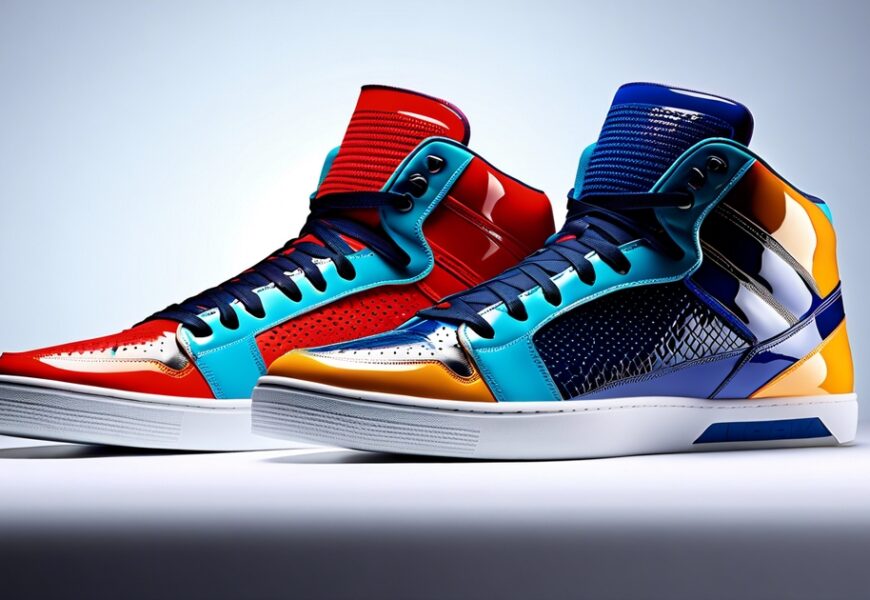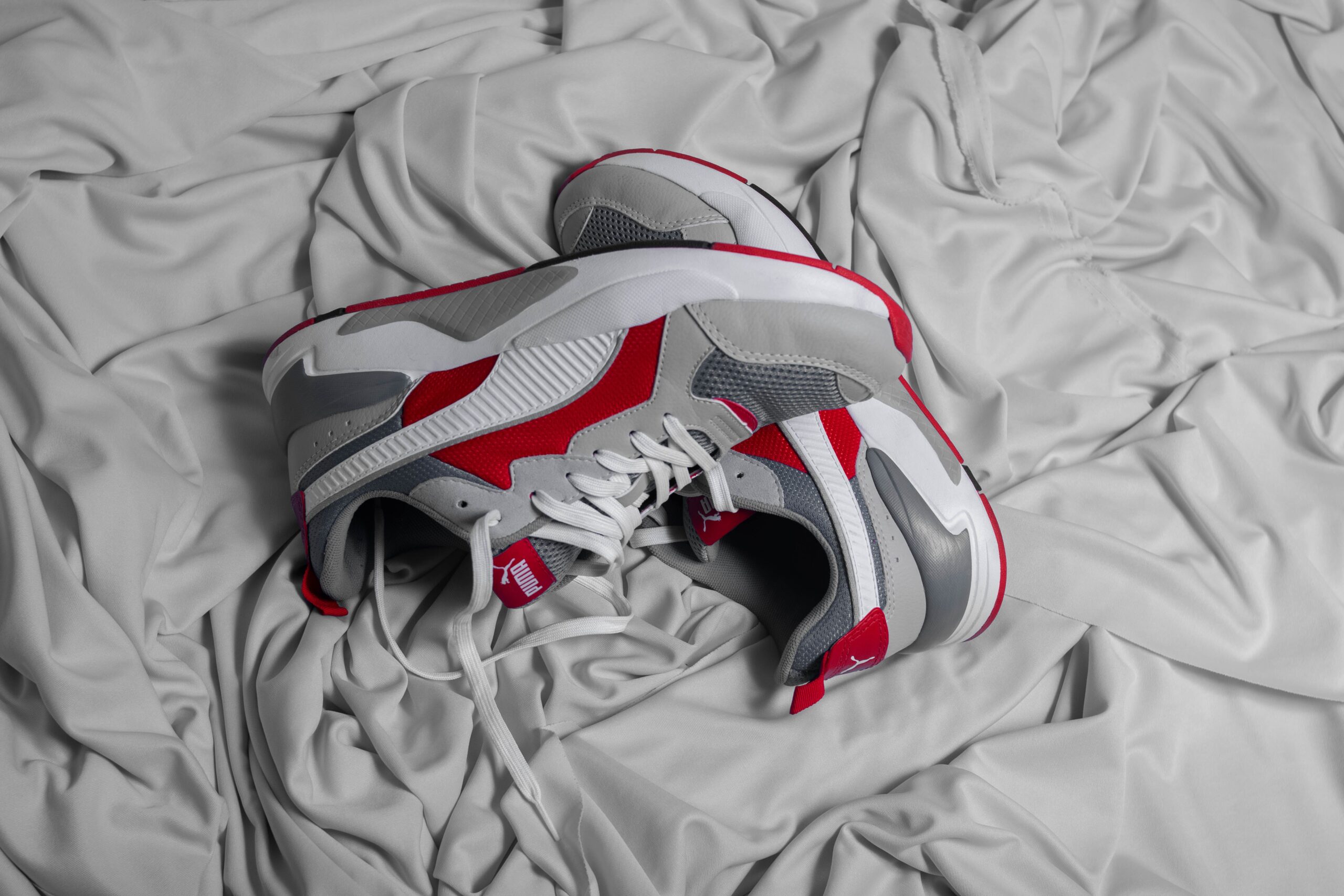How to Customize Sneakers: Tips for Personalizing Your Kicks
Do you want your sneakers to be as unique as you are? You can make custom-designed kicks that show off your personality and style. This guide will help you learn how to customize your sneakers and stand out from the crowd. You’ll learn about choosing the right fabric and mastering techniques like painting and embroidery. Whether you’re new to DIY or already love it, this guide will give you everything you need to get creative with your shoes.
Steps for Preparing Shoes for Customization
Self-Expression
Customizing sneakers with fabric, glue, and glitter lets you show off your style. You can use your favorite colors and designs to make the shoes totally unique. It’s a cool way to stand out from everyone else and feel confident in what you wear.
Artistic Creativity
Sneaker customization offers an outlet for artistic expression and creativity using fabric and glue. It provides an opportunity for individuals with a passion for art to turn plain fabric footwear into wearable masterpieces using glue. From hand-painting intricate designs to applying unique materials like studs or fabric patches, there are countless ways for artists to unleash their creativity on sneakers.
For instance, some artists use sneaker customization by incorporating relevant imagery or slogans onto the shoes. From choosing the right fabric to mastering techniques like painting and embroidery, we’ve got you covered.
Exclusivity
People like to customize sneakers to have cool shoes that show their style. They use fabric and glue to make unique designs, so no one else has the same shoes. This makes the customized sneakers extra special and valuable.
Lots of people like to have special and rare sneakers. They make them even more unique by painting them or adding cool stuff like crystals or metallic accents.
Materials Needed for Sneaker Customization
Essential Materials
- Paint made for fabric and leather (e.g., acrylic leather paint, Angelus leather paint)
- Soft brushes for painting and embroidery
- Good primer for preparing the sneaker for painting
- Protective finishers such as matte or glossy sealants
Different Types of Paint
There are different paints for customizing sneakers. Acrylic paints are good for beginners because they come in many colors and finishes. Airbrush paints are good if you want flexible designs that won’t crack or chip. You can also use fabric markers for detailed designs like logos or small patterns.
Additional Tools Required
- Heat gun: sets paint onto shoe material quickly and prevents smudging during layering applications
- Masking tape: aids in achieving clean lines between different sections of color and protects areas not meant to be painted
- X-Acto knife: assists in precise detailing by scraping off excess paint without causing damage
Steps for Preparing Shoes for Customization
Cleaning and Prepping
Before you start customizing your sneakers, it’s crucial to ensure that they are clean and free from any dirt or grime. Use a gentle shoe cleaner or a mild soap with water to thoroughly clean the surface of the shoes. Once cleaned, let them air dry completely before moving on to the next step. This ensures that the paint or other customization materials adhere properly to the shoe surface.
It’s important to pay attention to details such as removing laces and inserts before cleaning your sneakers. Taking these off will make it easier for you to clean every nook and cranny of your shoes without missing any spots. Removing laces and inserts prevents them from getting stained during the cleaning process, ensuring that every part of your sneakers is ready for customization.
Sanding for Better Adhesion
After cleaning and drying the shoes, consider sanding their surface lightly using fine-grit sandpaper. This step helps create a slightly rough texture on the shoe’s material, which can significantly improve adhesion when applying paints or other materials later on in the customization process.
Sanding also helps remove any remaining factory finish or protective coatings on certain parts of your sneakers’ surfaces. By doing this, you’re essentially creating an ideal canvas for better adherence of custom paints or dyes while also allowing primers and sealers to bond effectively with the shoe material.
Masking Sneakers for Painting
Importance of Masking Off Specific Areas
When customizing sneakers, masking off specific areas is crucial to ensure a clean and professional finish. By using painter’s tape effectively, you can protect the parts of the shoe that you don’t want to paint. This prevents any accidental smudges or spills on areas such as soles, laces, or fabric that should remain untouched.
It’s essential to take your time when masking off specific areas, ensuring that the edges are firmly sealed with the tape. This will prevent any paint from bleeding through onto unwanted sections of the sneaker. The precision in this process plays a significant role in achieving a polished and high-quality customized design.
Using Painter’s Tape Effectively
Painter’s tape is an indispensable tool. It provides a clean edge without leaving behind any sticky residue after removal. When applying painter’s tape, make sure to press down firmly along the edges where you want to create separation between painted and unpainted sections.
To utilize painter’s tape effectively, start by cutting small pieces and carefully placing them around the areas you wish to protect. For instance, if you’re painting only a portion of the sole or creating patterns on certain panels of the shoe, use precise strips of painter’s tape accordingly.
Techniques for Creating Clean Lines and Patterns
Various techniques can be employed for creating clean lines and patterns while customizing sneakers. One popular method involves using stencils in combination with masking techniques to achieve intricate designs with sharp lines.
Another technique is freehand painting but requires steady hands and meticulous attention to detail when masking off different sections throughout each step of painting.
Moreover, employing multiple layers of thin coats rather than one thick layer helps maintain crisp lines as excess paint can cause bleeding under the edges of masking materials.
Applying Paint and Adding Designs
Evenly Applying Base Coats
To customize sneakers, first put on a base coat evenly. This makes sure the paint sticks well and gives a good base for your designs. Use a good brush or airbrush to avoid clumps or streaks. Put on thin layers of paint and let each layer dry before adding more. This helps stop smudges or uneven coverage.
When applying the base coat, consider using acrylic leather paints specifically designed for sneakers. These paints are flexible and durable, allowing the shoes to bend and flex without cracking or peeling. They come in a wide range of colors, giving you plenty of options to create your desired look.
It’s essential to work in a well-ventilated area when applying paint to sneakers. Consider wearing a mask to avoid inhaling fumes from the paint, especially if you’re working indoors.
Using Stencils and Freehand Techniques
After painting the base coat, you can use stencils and freehand techniques to make cool designs on your sneakers. Stencils are good for making precise patterns or logos. Just tape the stencil down and dab on the paint with a sponge tool. If you want more freedom, use fine-tip brushes or fabric markers to draw whatever you want directly onto the shoe. You can make flowers, shapes, or even your initials – there’s no limit to what you can create!
Layering Colors and Textures for Depth
To elevate your customized sneakers further, experiment with layering colors and textures for added depth and dimensionality in your designs. For instance:
- Create gradients by blending two complementary shades together seamlessly.
- Add metallic accents using specialized paints that shimmer under different lighting conditions.
- Incorporate textures like splatter effects or raised 3D elements using fabric glue combined with materials such as glitter or small beads.
Layering allows you to build visual interest within your customizations while showcasing intricate details that catch attention from afar.
Removing Masking Tape and Cleaning Up
Peeling Off
After you’ve finished applying the paint and adding designs to your sneakers, it’s time to remove the masking tape. Carefully peel off the tape from the areas where you don’t want paint. Start by pulling at a 45-degree angle to prevent any smudging of the freshly painted areas.
It’s crucial to do this slowly and steadily, ensuring that no paint gets pulled up with the tape. If you notice any resistance or see that paint is coming off with the tape, use a craft knife or razor blade to gently cut along the edge of the tape before continuing to peel it off.
Cleaning Up Spills and Smudges
In customizing sneakers, spills or smudges are inevitable during painting. To clean up these accidental mishaps, use a cotton swab dipped in an appropriate solvent for your chosen type of paint. Gently dab at any unwanted marks until they lift away without spreading further onto other parts of your design.
For water-based paints like acrylics, using water on a cotton swab can also effectively remove small spills without damaging surrounding areas. Remember not to rub vigorously as this might smear or spread the spill instead of removing it cleanly.
Allowing Paint to Dry Completely
Before moving on to wearing or displaying your newly customized sneakers, ensure that all layers of paint have thoroughly dried. Rushing into removing masking tapes or attempting cleanup while the paint is still wet can lead to smearing and ruining all your hard work.
Make sure to give each coat of paint enough time to dry, especially if you’re using different colors. It might take longer if it’s really hot or humid where you’re painting. It’s best to wait at least a whole day before touching the paint.
Detailing Techniques for a Unique Finish
Adding Fine Details
When customizing sneakers, adding fine details can make them truly unique. You can use small brushes or markers to create intricate designs. For example, you could paint tiny flowers, geometric shapes, or even miniature characters on the shoes. These fine details will add a personal touch and set your customized sneakers apart from others.
Adding fine details is an opportunity to express your creativity and showcase your artistic skills. Whether it’s hand-painting delicate patterns or drawing small symbols that hold significance to you, these little touches can transform a plain pair of sneakers into wearable art.
Incorporating Textures
Incorporating textures such as splatter or fade effects can elevate the overall look of the customized sneakers. Splatter effects can give the shoes an edgy and dynamic appearance, while fade effects create a gradient-like transition between colors. By experimenting with different textures, you can achieve visually striking results that reflect your individual style.
Textures not only add visual interest but also provide tactile dimension to the design. When someone looks at your customized sneakers, they’ll not only see captivating visuals but also feel the varying textures under their fingertips.
Utilizing Different Finishes
Utilizing different finishes like matte or gloss allows you to further customize the appearance of the sneakers. A matte finish creates a soft and non-reflective surface, giving off an understated vibe. On the other hand, a glossy finish adds shine and vibrancy to the shoes’ exterior.
Different finishes offer versatility in expressing your aesthetic preferences through variations in sheen and texture. Depending on whether you want a subtle or bold look for your customized sneakers, choosing between matte or gloss finishes will significantly impact their overall appeal.
Applying Sealant for Durability
Importance of Sealing
Customizing sneakers is a fun and creative way to express your style, but it’s essential to protect your hard work. Sealing the customized design is crucial for ensuring its longevity and preventing the artwork from fading or wearing off. Without proper sealing, the vibrant colors and intricate details of your custom design could quickly deteriorate with regular wear.
Sealants act as a protective barrier against moisture, dirt, and friction. They help maintain the integrity of the design by preventing it from smudging or peeling off. By applying a sealant, you can enjoy your personalized sneakers for an extended period without worrying about them losing their visual appeal.
Choosing the right sealant is vital to ensure that it effectively protects the customized design without altering its appearance or texture. For fabric-based sneakers, acrylic finishers are commonly used as they provide flexibility while offering excellent protection against water and stains. On the other hand, if you’ve worked on leather or vinyl shoes, using a leather sealer would be more suitable due to its compatibility with these materials.
It’s essential to consider factors such as flexibility, breathability (for fabric shoes), resistance to cracking or yellowing over time when selecting a sealant for your customized sneakers.
Application Technique
When applying sealant to customize sneakers, remember that thin layers are key! Instead of one thick coat which can alter textures and appearances; apply multiple thin layers allowing each layer ample time to dry before adding another one.
Start by cleaning the surface of the shoe thoroughly using mild soap and water then allow it enough time to dry completely before beginning any sealing process. Once ready start applying thin coats in even strokes across all areas where customization has been done. Allow each layer sufficient drying time according to manufacturer instructions before adding another coat – this typically ranges between 15-30 minutes depending on environmental conditions. After completing several coats (usually 2-3), leave them undisturbed for at least 24 hours allowing ample curing time before wearing them again.
Tips and Tricks for Wearing Customized Kicks
Proper Care for Longevity
To ensure your customized sneakers stay in top condition, it’s crucial to clean them regularly. Use a gentle brush or cloth to remove dirt and stains. Avoid using harsh chemicals that can damage the custom design. Store your sneakers in a cool, dry place when not in use to prevent color fading or cracking.
When cleaning customized kicks, always follow the specific care instructions provided by the manufacturer of the base shoe. This is especially important if you’ve used paint or other materials that require special maintenance. Applying a sealant after customizing your sneakers can also help protect the design from wear and tear over time.
Styling Techniques to Highlight Your Design
Choosing complementary clothing and accessories can enhance the impact of your customized kicks. For instance, if your sneakers feature vibrant colors, opt for neutral-toned outfits to create a balanced look that allows the shoes to stand out. Conversely, if your custom design includes subtle details, consider pairing them with bold clothing choices to draw attention to the unique elements of your footwear.
Layering different textures and patterns in your outfit can also add visual interest without overshadowing your customized sneakers. Mixing and matching various pieces allows you to create an ensemble that accentuates rather than competes with the distinctive style of your shoes.
Refreshing or Updating Your Design Over Time
As trends evolve and personal preferences change, you might want to refresh or update the design of your customized kicks periodically. One way to achieve this is by adding new embellishments such as studs, patches, or fabric accents onto the existing customization.
Another option is repainting certain sections while preserving elements of the original design that you still love. You could even collaborate with an artist on a new concept for revamping your sneakers’ appearance altogether – perhaps incorporating different techniques like airbrushing or embroidery for a fresh take on personalized footwear.
Closing Thoughts
Congratulations! You’ve now learned the ins and outs of customizing sneakers like a pro. With the right materials, techniques, and a dash of creativity, you can turn any pair of kicks into a personalized masterpiece that reflects your unique style. So, what are you waiting for? Grab those sneakers and let your imagination run wild!
Now it’s your turn to unleash your inner artist and give those plain old sneakers a new lease on life. Don’t be afraid to experiment with different designs, colors, and detailing techniques. The world is your canvas, and your sneakers are the perfect medium to showcase your individuality. Get ready to step out in style with your one-of-a-kind creations!
Frequently Asked Questions
How long does it take to customize a pair of sneakers?
Customizing sneakers can take anywhere from a few hours to a couple of days, depending on the complexity of the design and the techniques used. It’s important to allow sufficient time for each step, ensuring quality results.
What type of paint is best for customizing sneakers?
Acrylic leather paints are commonly recommended for sneaker customization due to their durability and flexibility. They adhere well to various materials used in sneakers and offer vibrant color options. Always ensure that the paint is specifically designed for use on leather or fabric.
Can I use regular masking tape for airbrushing my sneakers?
Using high-quality painter’s tape or specialized low-tack masking tape designed for delicate surfaces is crucial when preparing your shoes for painting. Regular masking tape may leave residue or damage the shoe material, affecting the final outcome.
Do I need any special equipment like super glue, fabric, or airbrushing to start customizing my own sneakers?
Basic tools such as brushes, paints, sealants, and masking tapes are essential for sneaker customization. Having access to an airbrush can provide more precise detailing options but isn’t mandatory if you’re just starting out.
How do I ensure that my customized sneakers, fabric, and sealant will last longer?
Applying a quality sealant after completing your design not only enhances durability but also protects against scuffs and weathering. This extra layer acts like a shield against everyday wear and tear while preserving the vibrancy of your artwork.









